|
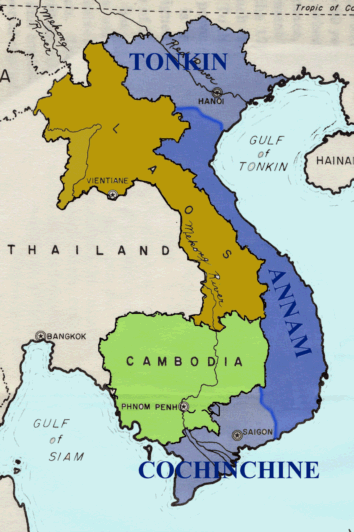 In September 1940, the French Vichy government granted Japan's demands for military access to Tonkin for their war against China. The Japanese occupied French Indochina with superior forces and left the French military, bureaucracy and leadership in place to run Indochina. After Pearl Harbor, the Japanese coerced the Vichy government to sign an agreement to pass on the administration of Indochina to the Japanese, in all but in name. Once the allied landed in Normandy and France was liberated, the Japanese realised that they could no longer rely on the Vichy French collaboration in Indochina and decided on the 9th of March 1945 to eliminate French Indochina colonial structure and military forces and executed or interned all French troops as well as many civilians. The Japanese declared Vietnam independent and gave power to the emperor Bao Dai. In September 1940, the French Vichy government granted Japan's demands for military access to Tonkin for their war against China. The Japanese occupied French Indochina with superior forces and left the French military, bureaucracy and leadership in place to run Indochina. After Pearl Harbor, the Japanese coerced the Vichy government to sign an agreement to pass on the administration of Indochina to the Japanese, in all but in name. Once the allied landed in Normandy and France was liberated, the Japanese realised that they could no longer rely on the Vichy French collaboration in Indochina and decided on the 9th of March 1945 to eliminate French Indochina colonial structure and military forces and executed or interned all French troops as well as many civilians. The Japanese declared Vietnam independent and gave power to the emperor Bao Dai.
15th August 1945, Japanese forces surrendered and where disarmed to the North of the 16th parallel by the Chinese and to the south by the British.
Ho Chi Minh, an anti Japanese OSS backed communist fighter in the mean time had organized a movement for Vietnamese independence, known as the Viet Minh with which he seized Hanoi on 2 September 1945 and declared the Democratic Republic of Vietnam. A campaign of terror against the French and all its sympathiser was launched and at Saigon the situation deteriorate with the French civilians been assembled in a central ghetto, starved and murdered. The few French troop still imprisoned were powerless.
 On the 12 of September 1945,
On the 12 of September 1945,
a company of the French 5th RIC and British troops were airlifted from Rangoon (Burma) to try to stabilise the situation and
rescue civilians. A cease fire did not occur
until the 2nd of October after the arrival of more
troops from the
"Corps Expeditionnaire Francais d ‘Extreme-Orient" (CEFEO) led by General Leclerc.
Leclerc had asked for 500 000 troops, but only 75 000 men were
allocated to the CEFEO. Re-exerting
of French authority was gradual and slow with most forces pushing
North of Saigon. The 5th RIC liberated Ban Me
Thuot after fierce fighting on the 2nd of December 1945.
By February 1946 French troops re-entered northern Vietnam and by the end of 1946 most major towns were under French control, but with most of the country side still under Viet Minh rules.
|
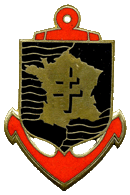 The
CEFEO, Corps
Expéditionnaire Français en Extrême-Orient,
CEFEO The
CEFEO, Corps
Expéditionnaire Français en Extrême-Orient,
CEFEO
was created in 1945 to rescue the
overwhelmed "Indochina French
Forces" fighting the
Japanese. General Leclerc
was nominated commander of the CEFEO in
June 1945 and
by August 15 received command of the Far
East French Forces.
The CEFEO was made of troops from
WWII free French army and from the
French Union colonial territories and
the French Foreign LegionThe entire
Chief of Staff were from the metropole as
well were volunteers from the colonial
airborne units (BCP, BCCP).
|
By 1948 the French started to employ their newly arrived Elite paratroopers
and by the end of 1948 over 40 combat jumps had been done.
By Mid 1949 the French Union troops reach 150 000 men with most of
t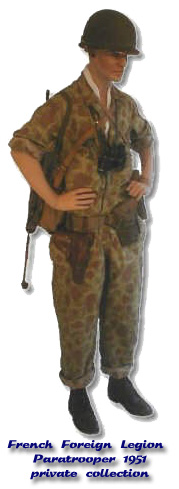 hem tied up to static defensive positions. Most of the French offensive operations were carried by the French Para reaching around 5700 men by 1950. hem tied up to static defensive positions. Most of the French offensive operations were carried by the French Para reaching around 5700 men by 1950.
By 1949 the war
started to been
seen as an "anti communist expansion war" and US financial
help started filtering through. From 1950 onwards, the French war effort was greatly financially sustained by the US, but with the condition of the French working towards a Vietnamese independence and towards the creation of a Vietnamese National Army. The creation of the Vietnamese Army was not a problem as General De Lattre had started
his "jaunissement programe" (Yellowing process);
A) to raise much needed troops that was no longer available from
France and her Colonies
B) to involve more the Vietnamese into doing their own fighting against the Viet
Minh..
Indochina was reorganized in 1950, in three monarchies Laos, Cambodia, Vietnam which
were granted the status of independence within the French Union. French influence was very dominant and French Unions troops carry on fighting Communist invasions.
Also
by
1950 the war had turned into a slightly more conventional
war against a Communist invasion coming
down from the
north (with massive help from China).
Back in France, the Indochina war was still not
supported by the population or its ever changing governments! It was
still seen seen as a "Dirty
Colonial war" and was referred by the French
communist as " la sale guerre".
In 1950 Ho Chi Minh and the Viet Minh were re-cognized by China as the true Government of Vietnam and Chinese help started pouring in.
In September 1950 Viet Minh forces lead by General Giap started
to attack and over run all the French forts along the Chinese
border, four paratroops battalion were dropped to try to
relieve/rescue French troops but were virtually wiped out by the
shear number of VM ( despite outstanding fighting on the French
side), the infamous RC4 road will be remembered for its slaughter.
By the 17 of December 1950, Marshal De Lattre de
Tassigny, a famous French commander from WWII took over control of the troops and redressed the situation.
In January 1951 General Giap forces received their first major defeat at Vinh Yen (leaving 6000 dead), followed by Mao Khe and Ninh Binh. In November 1951, 2000 para jumped and capture Hao Binh, a major Viet supply centre, French ground and riverine forces soon followed. The Viet Minh tried to encircled and suffocate the French but the Black River and the Road Colonial No 6 were kept open at high cost through out December. 1951 saw the birth of General De Lattre de Tassigny "jaunissement" program* which was aiming to the creation of a National Vietnamese Army. 1951 also saw the creation of the GCMA (Groupement des Commando Mixtes Aeroportes), the equivalent of the US Special Forces in Vietnam with a similar mission running SOG type operations and similar program to the CIDG. In Mai 1951, the first C.I.P.L.E (Compagnie Indochinoise Parachutiste de la Legion Etrangere) was created, this in effect was a fourth (Vietnamese) company added to the BEP (Battalion Etranger
Parachutiste). These companies fought very well showing that Vietnamese Soldiers if well trained and well lead could be as effective as French units (note that NCO and Officers were experienced Legionnaires) . Late that year, De Lattre was evacuated back to France dying of cancer.
By the 2nd week of January 1952, the situation deteriorated for the French in Hao Binh, as the Viet managed to close the Black River then Road Colonial No 6. After 11 days of fighting along the road No 6 a rescue column reached the town which then was evacuated successfully with massive air support and at high human cost due to the usual Viet Minh human wave attacks.
The rest of 1952 saw French troops
being bogged down in defensive positions with their controlled
territory shrinking. The only significant French victory was
on the Parfume River coast were 3000 VM were killed during an
amphibious operation. In October, Giap started is offensive
in the T'ai hills, strategic ground for his "highway" to
the south, ie the Mekong river.

In mid October the 6th BCP (Bigeard
Battalion) was drop on Tu Le in front of the advancing VM
army to slow them down and to allows the evacuations of many
threaten small forts in the region. 574 para held up
for a night against the 312th VM division (10 000 men) and then
accomplished a 72 hours/40 miles jungle fighting retreat with
practically no air support due to the low clouds. By November most
T'ai hills were under the control of the VM, but it should be
noted that the GCMA guerrilla would be operating
successfully in that area for a long time. In late October
to relieve the pressure, a major French offensive
"Operation Lorraine "was launch into VM controlled
territory around the Red River with 30 000 French Union troops,
they penetrated deeply into enemy territory but with no major
success as the Viet Minh refused to engage and vanish. Due to the
logistical problem of maintaining this spearhead supplied, a
withdrawal started with the French forces falling into a well
position ambush inflicting them heavy casualty.
In November 1952, General Salan
decide to create a huge fighting camp in the Na San valley south
of the Black river to block the two main invasion routes to the
T'ai highlands. This camp will be manned by 12 French
battalions, with an air strip and artillery. From the 2nd
to the 4th of December, general Giap will through human waves
after waves at the camp, (for example the PA 21 and PA 26 (point
d'appuis) held by 707 Legionnaire will be assaulted by the TD
209 (3000 Bo Dois) and will hold due to artillery and air
support). After two bloody days for the Viet Minh, Giap gave up,
and (unfortunately) the idea of
massive fighting camp to engage and defeat the enemy was born in the French High Command strategy.
In
1952 the French war budget was increased from 281 billions spent
the previous year to 399 billions, with the US providing
40% of it under various forms .
1953 the Viet Minh started
moving its forces into northern Laos, French forces already
stretched to the maximum were unable to reinforce theirs troops
in Laos and all French fort were told to hold as long as
possible. In July, in Central Annam, the
"Operation Camargue", a combined
Amphibious/Airborne/Ground operation was launched to clear the
VM from the "Street Without Joy", nicknamed given
to Road Colonial No 1 in the costal area north of Hue. French
forces once more were spread to thin and the operation missed
its main objectify of destroying the VM regiment 95 and
only achieved the destruction of one of its company but the VM
was flushed out and RC1 was reopen.
Another important factor in
late 1953 was the birth of the "Groupement mobile 100",
which for one of its main Battalions had
the "French
battalion de Corée" (which fought in Korea with the 2n US Inf Div). That year the GCMA was also renamed the GMI (Groupement Mixtes D'intervention) and would be
controlling 15 000 irregulars by the end of 1954.
On
20th of November 1953, an airborne assault (4525 men) was
launched to recapture the old Japanese air strip of Dien Bien
Phu, and establish an operational base to stop and engage
the Viet Minh, the beginning of the end was about to unfold. See
Dien Bien Phu page!
The fall of Dien Bien Phu in Mai 1954 was a very high blow to French moral but was not in
military term a significant defeat. The French Expeditionary
Corps and Associated States Armies lost 15 000 troops which
equated to 3.3 % of their numerical strength against a lost of
25 000 VM troops. But
this did give the French government a firmer reason to seek a
way out of the Indochina conflict during the Geneva Peace Talks.
June1954
saw the French evacuation of the Tonkin delta and a Viet Minh
offensive in Central Annam. When An Ke got cut off from Pleiku,
it was decided to evacuate the town in an operation called
"Eglantine". Two French motorized groups GM100
and GM42 would travel half way and meet in the middle to rejoin
Pleiku. In a succession of Viet Minh road ambushes GM100 was
virtually annihilated in late June.
On the 21 July 1954 Prime Minister, Pierre Mendes-France informed the French
Parliament that he had achieved "an honourable
settlement" to end the war in Indochina which had cost over 300 000 lives.
What he conveniently forgot to tell, that he was abandoning
Vietnamese and ethnic minority (which supported France) to a violent and dark future. The French withdrawal of Tonkin after the cease fire condemned the GMI partisan and their French
officers/NCO serving in Maquis in North Vietnam and Laos to a sure death.
The
cease fire was implemented on the 27th. The terms agreed were
shocking with the country divided on the 17th parallel into two.
The French would withdraw from the North and Viet Minh from the
South by the 9th of October. For 300 days, free movement of the
population would be allowed and partition would last until July
1956 when countrywide election would take place to decide the
political future of Vietnam. Until that time the CEFEO would
continue to protect South Vietnam. A vital clause for the
French was the release of 11 000 French POW between August to
October 1954. When the French prisoners were released, receptions
parties were chocked by their physical conditions. Many men had
been in Viet Minh hands since May 1954 and bore resemblance to
WWII prisoners of Buchenwald or Changi jail. The French
authorities did not protest in fear of compromising future
prisoners release.
*
elections will be held in 1956 with the aim of creating a unified
government
*
prisoners of war will be released on both side (WELL
MAINLY BY THE FRENCH, SEE THE FIGURES BELOW!)
* French forces will withdraw from the north and the Viet Minh from
the south and the
Communists will recognise Laos and Cambodia as independent
countries and agree to the withdrawal of their forces from both.
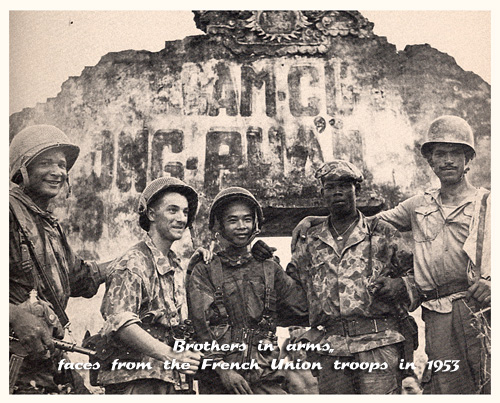
The Indochina tour of duty
was two years and only the regular army was
allowed to serve in Indochina (no conscript unless volunteers). It was not uncommon for many officers and NCO to extend their tours to three years and sometime four years and
late in the war, most soldiers were on there second tour with some being on there third tour. This meant that the returning few NCO and officers were very experienced and had
a very good understanding of the conflict. During most of the war, the under-manned/under equipped French army was only able to exercise effective French control in the low-lands and in populated areas of Cambodia, Laos, North and South Vietnam, the rest of the country side was dominated by the Viet Minh apart from Maquis controlled zone and very local area around French outposts and forts.
No conscripts were used in Indochina (unless volunteers) but as casualty increased and ex main land WWII troops were killed or repatriated,
the need for fresh troops rose and more French Union colonial troops were called on
from Morocco, Algeria, Tunisia and Africa. These troops
combativity varied from poor to excellent according to their leadership,
unfortunately due to sustained high
casualty, NCO and junior officers were always to few, with their best one often going to the Para or the Legion.
The French Union Forces soldiers had fought courageously in Indochina but lack of equipment, air support, man power, the lack of support from their own government as well as the indecisiveness and some time over confidence of the High command doomed the French Forces to a defeat. An other contributing factor in their defeat was the
non continuity during the eight years of war, of French
commanders in Chief (seven) and political
governors (six), the Viet Minh only had one political Leader
Ho Chi Minh
and one commander in chief Giap
and therefore stayed more focused.
It is interesting to know that at
the beginning of the Indochinese conflict, the US was quite hostile to the French and
favored Vietnam as an independent democratic country. They regarded the war as a purely French colonial war but their attitude changed after the victory of Mao Tse Tung in China and their involvement in the Korean war.
By 1954 the US was covering about 80% of the financial cost of the Indochina war.
The
main provisions of the Geneva Accord were
*
Vietnam will
be divided between north and south along the 17th parallel
*
a Communist
government under Viet Minh leader Ho Chi Minh will control the
north and a nationalist one in the south under Emperor Bao Dai and
prime minister Ngo Dinh Diem
*
the capitals
will be Hanoi in the north and Saigon in the south
........................................................
|
"Jaunissement"
or
"yellowing process"
was
the French program to increase
fighting forces numbers and strength
by creating a National Vietnamese army
and as well as integrating some
Vietnamese forces within French forces .
Each French Foreign Legion regiment
formed a composite battalion and each
French Legion battalion
added a mixte company.
In
1950
30 000 Vietnamese regulars and
35 000 auxiliaries
where fighting with the French,
by 1952 this increased to
54 000 regulars
58 000 auxiliaries
with a further 15 000 in training.
Auxiliaries unfortunately were often placed with a couple of
French soldiers in isolated outposts
which did not achieved much
when not supported by the local population.
These outposts were
also very vulnerable to sustained Viet Minh attacks and were a
good source
of weapons and ammo for the Viet Minh..
|
|
FEW FOB BADGES OUT OF
MY COLLECTION
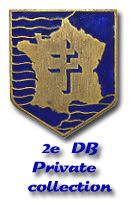
Groupement de Marche de la 2e
Division Blindée
Very Famous WWII French
Armoured division commanded by General
Leclerc,
this was one of the main
unit in the 1946 CEFEO.
(Corps Expeditionnaire Francais d
‘Extreme-Orient)

323e Compagnie
Supplétive Militaire
These were under strength
paramilitary company commanded by an
officer and couple of NCO,
they were similar to the
Vietnam Popular Forces/Regional
Forces.
These CSM were usually based at
small isolated outpost all over
Indochina.
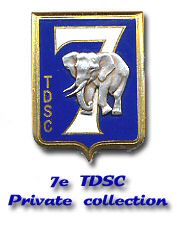
7e Bataillon
Montagnard
Created in February 1951 in
the Dalat region, it was part of the
4th Montagnard Division,
this
battalion was later on attached to
the Group Mobile 42, GM42.
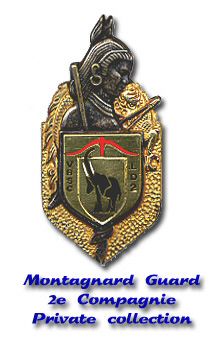
V.B.S.C. (Ve Binh Son-Cuo)
2e
Compagnie, Regiment de la
Garde Montagnarde des Plateaux du
Sud Indochine
This
regiment had 4 companies based in
the Central Highlands of South
Vietnam,
its officers and NCO were
issued from the "3ème
Légion de Marche de Garde Républicaine".
1st
company was based at Haut Donnai;
2nd
company
was based at
Ban
Me Thuot;
3rd company
was based at
Pleiku;
4th
company was based at
Kontum.
|
|